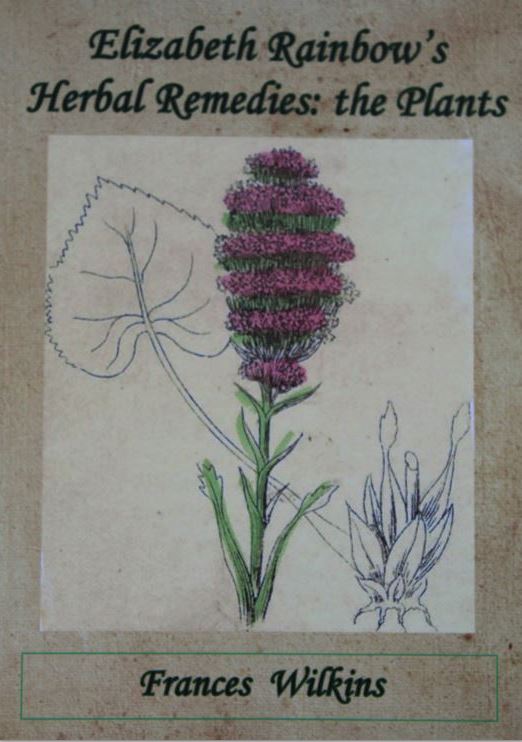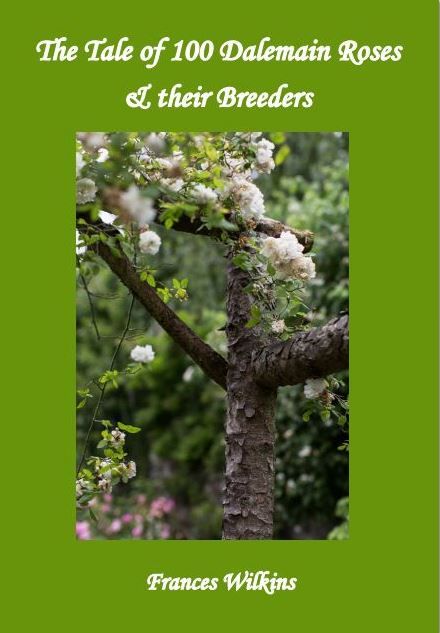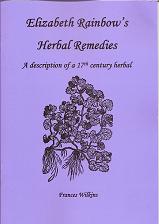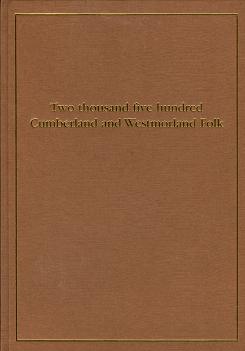Series Information: CUMBRIAN
This series includes two books based on the private archive at Dalemain mansion near Penrith: The Hasells of Dalemain and Two thousand five hundred Cumberland and Westmorland Folk; a book and a booklet based on a 17th century herbal: Elizabeth Rainbow's Herbal Remedies and Elizabeth Rainbow's Herbal Remedies: The Plants and a book abou. t the roses in the garden there: The Tale of 100 Dalemain Roses and their Breeders. There will be one more book about the family: Edward Hasell, Squire of Dalemain 1794 to 1824 to be published in 2021 or 2022.
Elizabeth Rainbow's Herbal Remedies: The Plants
Research into the ingredients of Elizabeth Rainbow's herbal remedies has continued since the launch of the first booklet about her herbal published in 2008. This new volume concentrates on the plants used in the remedies.
Events
Herbal Remedies 17th century Style: three day schools based on this book were planned at the National Stone Centre Wirksworth, Derbyshire as follows: Wednesday, 18 March 2020: The Spring Wild Flowers & Leaves Wednesday, 24 June 2020: The Summer Wild Flowers & Buds Wednesday, 23 September 2020: Seeds, Berries & Roots These will now be held in 2021 - please contact frances@franscript.co.uk for further details.
The Tale of 100 Dalemain Roses & their Breeders
There are more than 100 roses in the gardens at Dalemain. These were bred by people living in the UK, Europe and the Americas. This book considers the roses in the context of their breeders. The result is the first in a series of stories abut The History behind Rose Gardens.
Events
The rose tours at Dalemain are in the process of being converted to virtual events.
Elizabeth Rainbow's Herbal Remedies
During the second half of the seventeenth century, Elizabeth Rainbow, wife of the Bishop of Carlisle, collected recipes for herbal remedies, transcribing them into a large book. This booklet considers the sources used by Elizabeth Rainbow when collecting together her herbal remedies. The ailments that could be treated with these recipes and the types of treatments involved are summarised before a selection of the remedies is described and illustrated, using John Gerard's Herbal. Over 320 plants and plant products mentioned in Elizabeth's herbal remedies are listed in an Appendix.
Events
Herbal Remedies 17th century Style: three day schools based on this book were planned at the National Stone Centre, Wirksworth, Derbyshire as follows: Wednesday, 18 March 2020: The Spring Wild Flowers & Leaves Wednesday, 24 June 2020: The Summer Wild Flowers & Buds Wednesday, 23 September 2020: Seeds, Berries & Roots These will now be held in 2021 - please contact frances@franscript.co.uk for further details.
Two thousand five hundred Cumberland and Westmorland Folk appearing in the stewards' accounts at Dalemain between 1739 and 1794
This book was inspired by the comment: 'people don't want to hear about toffs but the working man'. What a challenge! Was it possible to use the stewards' accounts in the archive at Dalemain to repopulate parts of Cumberland and Westmorland in the eighteenth century? Would the result simply be a gazetteer of names or was there information available in the accounts that would give some idea of their lifestyles as well? What would be the final number of identifiable people? This book is divided into six sections: the Stewards and their Accounts; the Manors and Other Properties; the Labourers; the Professionals, Suppliers and Tradespeople; the Household Staff and the Creditors. For those readers not purely on the ancestor hunt but interested in the local history of the area and the lifestyles of the eighteenth century, if you enjoy this book then all the hours of work necessary to produce it will have been worthwhile.
Reviews
Handsomely produced and illustrated. The book provides a fascinating picture of the day-to-day work and maintenance involved in running estates. Those lucky enough to have ancestors in this area will find it a revelation about their working lives. It will also provide an invaluable source of information for local and social historians.Ancestors
For many the book will open new worlds. The family historian has an easy entry to the activities of thousands of individuals outside the usual run of births, deaths and marriages. Property historians have residence/ownership details and academic historians have masses of data on topics such as wages, prices, rents, economic activity and credit. To my mind this is an exciting contribution to the history of one specific local area in north Westmorland. I am sure it will be well-used and I hope it stimulates others to follow its approach. Cumberland & Westmorland Antiquarian & Archaeological Society Newsletter
... the author was able to track the estate's tenants, staff, suppliers and creditors down the years. Here are the labourers and maids down to the child who weeded corn. Here are the grocers, stationers and apothecaries. In all they add up to the two and a half thousand folk of the title. It does not make for light bedtime reading but is a fascinating insight into rural life of the time and it will be a godsend for those interested in the history of the area or tracing family trees. Cumbria
This book may be a godsend to anyone looking for ancestors in Cumberland and Westmorland during the latter half of the eighteenth century ... Well laid out, this A4 hardback contains many maps; some original documents and signatures are produced. An index of names rounds off extracts from a private estate archive which, without the energy of Frances Wilkins, would be known to just a handful of people. Family Tree MagazineThis is an excellent work of value to persons researching all elements of sociological, economic and genealogical history of Cumberland and Westmorland. FOCAS
The Hasells of Dalemain: A Cumberland Family 1736-1794
Williams, Edward, Christopher and John were the four sons of Edward and Julia Hasell of Dalemain, near Penrith. All were born in Cumberland but their lives were very different. From 1755 to 1758 Williams, the heir, attended Corpus Christi College, Oxford, without graduating. He then returned to Cumberland, where he occupied his time as a gentleman farmer and sportsman, owning a string of horses and a pack of hounds. He married Mary Gaskarth of Penrith in 1774 but died, childless, in 1786. Edward and Christopher sought their fortunes as merchants in Rotterdam and Liverpool, respectively. Edward was successful and returned to England a wealthy man but Christopher was 'unfortunate' in every venture he chose to undertake. John went to sea, eventually becoming the captain of East India Company vessels. This career ended somewhat abruptly and he spent time in both England and Wales before returning to India, where he died. Christopher was the first of the Hasell children to marry - and the first to die, leaving a widow, Elizabeth, and three children. For the next 21 years his brother Edward, a confirmed bachelor, acted as their guardian and adviser. There were also three sisters. Julia married Richard Houghton and lived in Liverpool until she became a widow, when she moved to Bath with her son Edward, away from the direct view of the family. William Salmond of Antigua married Jane. They spent part of their time in Cumberland, at Sizergh Castle and in Carlisle, before going out to the Salmond estates in the West Indies. When she was widowed, Jane and her children lived with her spinster sister, Mary, in York. The detailed story of this generation of Hasells, from the birth of Williams in 1736 to the death of Edward in 1794, is reconstructed from the contemporary family letters and accounts and from the business papers of Christopher and his son, Ned. The result is a vivid tale of an eighteenth century Cumberland family, which is of interest to both the local historian and the general reader.
2003
ISBN 978 1 897725 17 7
A4 256pp hardback
Out of Print



